Fan Feng
DEPTH: Hallucination-Free Relation Extraction via Dependency-Aware Sentence Simplification and Two-tiered Hierarchical Refinement
Aug 20, 2025Abstract:Relation extraction enables the construction of structured knowledge for many downstream applications. While large language models (LLMs) have shown great promise in this domain, most existing methods concentrate on relation classification, which predicts the semantic relation type between a related entity pair. However, we observe that LLMs often struggle to reliably determine whether a relation exists, especially in cases involving complex sentence structures or intricate semantics, which leads to spurious predictions. Such hallucinations can introduce noisy edges in knowledge graphs, compromising the integrity of structured knowledge and downstream reliability. To address these challenges, we propose DEPTH, a framework that integrates Dependency-aware sEntence simPlification and Two-tiered Hierarchical refinement into the relation extraction pipeline. Given a sentence and its candidate entity pairs, DEPTH operates in two stages: (1) the Grounding module extracts relations for each pair by leveraging their shortest dependency path, distilling the sentence into a minimal yet coherent relational context that reduces syntactic noise while preserving key semantics; (2) the Refinement module aggregates all local predictions and revises them based on a holistic understanding of the sentence, correcting omissions and inconsistencies. We further introduce a causality-driven reward model that mitigates reward hacking by disentangling spurious correlations, enabling robust fine-tuning via reinforcement learning with human feedback. Experiments on six benchmarks demonstrate that DEPTH reduces the average hallucination rate to 7.0\% while achieving a 17.2\% improvement in average F1 score over state-of-the-art baselines.
Null Counterfactual Factor Interactions for Goal-Conditioned Reinforcement Learning
May 06, 2025

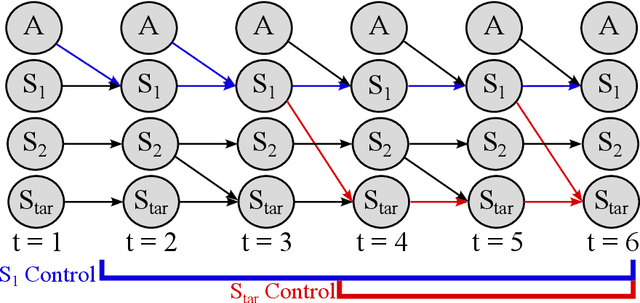

Abstract:Hindsight relabeling is a powerful tool for overcoming sparsity in goal-conditioned reinforcement learning (GCRL), especially in certain domains such as navigation and locomotion. However, hindsight relabeling can struggle in object-centric domains. For example, suppose that the goal space consists of a robotic arm pushing a particular target block to a goal location. In this case, hindsight relabeling will give high rewards to any trajectory that does not interact with the block. However, these behaviors are only useful when the object is already at the goal -- an extremely rare case in practice. A dataset dominated by these kinds of trajectories can complicate learning and lead to failures. In object-centric domains, one key intuition is that meaningful trajectories are often characterized by object-object interactions such as pushing the block with the gripper. To leverage this intuition, we introduce Hindsight Relabeling using Interactions (HInt), which combines interactions with hindsight relabeling to improve the sample efficiency of downstream RL. However because interactions do not have a consensus statistical definition tractable for downstream GCRL, we propose a definition of interactions based on the concept of null counterfactual: a cause object is interacting with a target object if, in a world where the cause object did not exist, the target object would have different transition dynamics. We leverage this definition to infer interactions in Null Counterfactual Interaction Inference (NCII), which uses a "nulling'' operation with a learned model to infer interactions. NCII is able to achieve significantly improved interaction inference accuracy in both simple linear dynamics domains and dynamic robotic domains in Robosuite, Robot Air Hockey, and Franka Kitchen and HInt improves sample efficiency by up to 4x.
* Published at ICLR 2025
Generative AI Application for Building Industry
Oct 01, 2024



Abstract:This paper investigates the transformative potential of generative AI technologies, particularly large language models (LLMs), within the building industry. By leveraging these advanced AI tools, the study explores their application across key areas such as energy code compliance, building design optimization, and workforce training. The research highlights how LLMs can automate labor-intensive processes, significantly improving efficiency, accuracy, and safety in building practices. The paper also addresses the challenges associated with interpreting complex visual and textual data in architectural plans and regulatory codes, proposing innovative solutions to enhance AI-driven compliance checking and design processes. Additionally, the study considers the broader implications of AI integration, including the development of AI-powered tools for comprehensive code compliance across various regulatory domains and the potential for AI to revolutionize workforce training through realistic simulations. This paper provides a comprehensive analysis of the current capabilities of generative AI in the building industry while outlining future directions for research and development, aiming to pave the way for smarter, more sustainable, and responsive construction practices.
Towards Generalizable Reinforcement Learning via Causality-Guided Self-Adaptive Representations
Jul 31, 2024Abstract:General intelligence requires quick adaption across tasks. While existing reinforcement learning (RL) methods have made progress in generalization, they typically assume only distribution changes between source and target domains. In this paper, we explore a wider range of scenarios where both the distribution and environment spaces may change. For example, in Atari games, we train agents to generalize to tasks with different levels of mode and difficulty, where there could be new state or action variables that never occurred in previous environments. To address this challenging setting, we introduce a causality-guided self-adaptive representation-based approach, called CSR, that equips the agent to generalize effectively and efficiently across a sequence of tasks with evolving dynamics. Specifically, we employ causal representation learning to characterize the latent causal variables and world models within the RL system. Such compact causal representations uncover the structural relationships among variables, enabling the agent to autonomously determine whether changes in the environment stem from distribution shifts or variations in space, and to precisely locate these changes. We then devise a three-step strategy to fine-tune the model under different scenarios accordingly. Empirical experiments show that CSR efficiently adapts to the target domains with only a few samples and outperforms state-of-the-art baselines on a wide range of scenarios, including our simulated environments, Cartpole, and Atari games.
Dynamic Position Transformation and Boundary Refinement Network for Left Atrial Segmentation
Jul 07, 2024Abstract:Left atrial (LA) segmentation is a crucial technique for irregular heartbeat (i.e., atrial fibrillation) diagnosis. Most current methods for LA segmentation strictly assume that the input data is acquired using object-oriented center cropping, while this assumption may not always hold in practice due to the high cost of manual object annotation. Random cropping is a straightforward data pre-processing approach. However, it 1) introduces significant irregularities and incompleteness in the input data and 2) disrupts the coherence and continuity of object boundary regions. To tackle these issues, we propose a novel Dynamic Position transformation and Boundary refinement Network (DPBNet). The core idea is to dynamically adjust the relative position of irregular targets to construct their contextual relationships and prioritize difficult boundary pixels to enhance foreground-background distinction. Specifically, we design a shuffle-then-reorder attention module to adjust the position of disrupted objects in the latent space using dynamic generation ratios, such that the vital dependencies among these random cropping targets could be well captured and preserved. Moreover, to improve the accuracy of boundary localization, we introduce a dual fine-grained boundary loss with scenario-adaptive weights to handle the ambiguity of the dual boundary at a fine-grained level, promoting the clarity and continuity of the obtained results. Extensive experimental results on benchmark dataset have demonstrated that DPBNet consistently outperforms existing state-of-the-art methods.
YAYI 2: Multilingual Open-Source Large Language Models
Dec 22, 2023Abstract:As the latest advancements in natural language processing, large language models (LLMs) have achieved human-level language understanding and generation abilities in many real-world tasks, and even have been regarded as a potential path to the artificial general intelligence. To better facilitate research on LLMs, many open-source LLMs, such as Llama 2 and Falcon, have recently been proposed and gained comparable performances to proprietary models. However, these models are primarily designed for English scenarios and exhibit poor performances in Chinese contexts. In this technical report, we propose YAYI 2, including both base and chat models, with 30 billion parameters. YAYI 2 is pre-trained from scratch on a multilingual corpus which contains 2.65 trillion tokens filtered by our pre-training data processing pipeline. The base model is aligned with human values through supervised fine-tuning with millions of instructions and reinforcement learning from human feedback. Extensive experiments on multiple benchmarks, such as MMLU and CMMLU, consistently demonstrate that the proposed YAYI 2 outperforms other similar sized open-source models.
Conversational Recommender System and Large Language Model Are Made for Each Other in E-commerce Pre-sales Dialogue
Oct 23, 2023



Abstract:E-commerce pre-sales dialogue aims to understand and elicit user needs and preferences for the items they are seeking so as to provide appropriate recommendations. Conversational recommender systems (CRSs) learn user representation and provide accurate recommendations based on dialogue context, but rely on external knowledge. Large language models (LLMs) generate responses that mimic pre-sales dialogues after fine-tuning, but lack domain-specific knowledge for accurate recommendations. Intuitively, the strengths of LLM and CRS in E-commerce pre-sales dialogues are complementary, yet no previous work has explored this. This paper investigates the effectiveness of combining LLM and CRS in E-commerce pre-sales dialogues, proposing two collaboration methods: CRS assisting LLM and LLM assisting CRS. We conduct extensive experiments on a real-world dataset of Ecommerce pre-sales dialogues. We analyze the impact of two collaborative approaches with two CRSs and two LLMs on four tasks of Ecommerce pre-sales dialogue. We find that collaborations between CRS and LLM can be very effective in some cases.
Learning Dynamic Attribute-factored World Models for Efficient Multi-object Reinforcement Learning
Jul 18, 2023Abstract:In many reinforcement learning tasks, the agent has to learn to interact with many objects of different types and generalize to unseen combinations and numbers of objects. Often a task is a composition of previously learned tasks (e.g. block stacking). These are examples of compositional generalization, in which we compose object-centric representations to solve complex tasks. Recent works have shown the benefits of object-factored representations and hierarchical abstractions for improving sample efficiency in these settings. On the other hand, these methods do not fully exploit the benefits of factorization in terms of object attributes. In this paper, we address this opportunity and introduce the Dynamic Attribute FacTored RL (DAFT-RL) framework. In DAFT-RL, we leverage object-centric representation learning to extract objects from visual inputs. We learn to classify them in classes and infer their latent parameters. For each class of object, we learn a class template graph that describes how the dynamics and reward of an object of this class factorize according to its attributes. We also learn an interaction pattern graph that describes how objects of different classes interact with each other at the attribute level. Through these graphs and a dynamic interaction graph that models the interactions between objects, we can learn a policy that can then be directly applied in a new environment by just estimating the interactions and latent parameters. We evaluate DAFT-RL in three benchmark datasets and show our framework outperforms the state-of-the-art in generalizing across unseen objects with varying attributes and latent parameters, as well as in the composition of previously learned tasks.
U-NEED: A Fine-grained Dataset for User Needs-Centric E-commerce Conversational Recommendation
May 05, 2023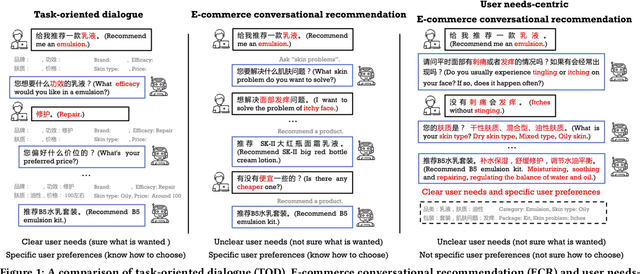
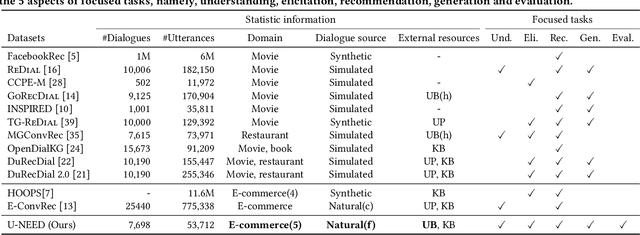
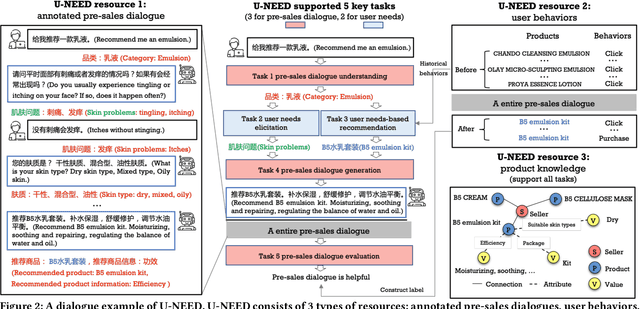
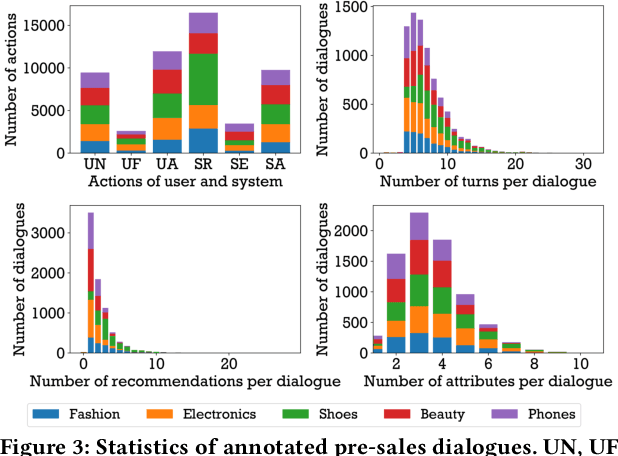
Abstract:Conversational recommender systems (CRSs) aim to understand the information needs and preferences expressed in a dialogue to recommend suitable items to the user. Most of the existing conversational recommendation datasets are synthesized or simulated with crowdsourcing, which has a large gap with real-world scenarios. To bridge the gap, previous work contributes a dataset E-ConvRec, based on pre-sales dialogues between users and customer service staff in E-commerce scenarios. However, E-ConvRec only supplies coarse-grained annotations and general tasks for making recommendations in pre-sales dialogues. Different from that, we use real user needs as a clue to explore the E-commerce conversational recommendation in complex pre-sales dialogues, namely user needs-centric E-commerce conversational recommendation (UNECR). In this paper, we construct a user needs-centric E-commerce conversational recommendation dataset (U-NEED) from real-world E-commerce scenarios. U-NEED consists of 3 types of resources: (i) 7,698 fine-grained annotated pre-sales dialogues in 5 top categories (ii) 333,879 user behaviors and (iii) 332,148 product knowledge tuples. To facilitate the research of UNECR, we propose 5 critical tasks: (i) pre-sales dialogue understanding (ii) user needs elicitation (iii) user needs-based recommendation (iv) pre-sales dialogue generation and (v) pre-sales dialogue evaluation. We establish baseline methods and evaluation metrics for each task. We report experimental results of 5 tasks on U-NEED. We also report results in 3 typical categories. Experimental results indicate that the challenges of UNECR in various categories are different.
A Benchmark and Empirical Analysis for Replay Strategies in Continual Learning
Aug 04, 2022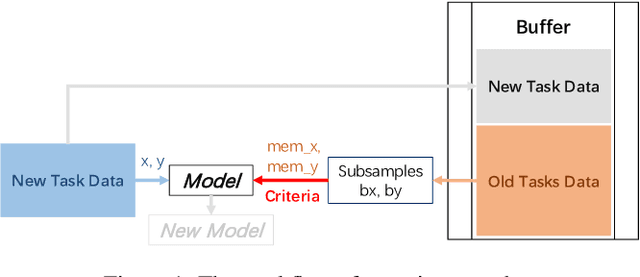

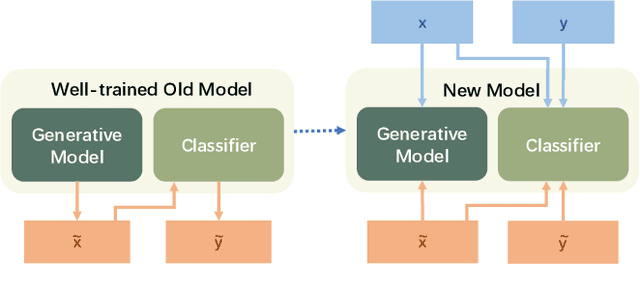

Abstract:With the capacity of continual learning, humans can continuously acquire knowledge throughout their lifespan. However, computational systems are not, in general, capable of learning tasks sequentially. This long-standing challenge for deep neural networks (DNNs) is called catastrophic forgetting. Multiple solutions have been proposed to overcome this limitation. This paper makes an in-depth evaluation of the memory replay methods, exploring the efficiency, performance, and scalability of various sampling strategies when selecting replay data. All experiments are conducted on multiple datasets under various domains. Finally, a practical solution for selecting replay methods for various data distributions is provided.
 Add to Chrome
Add to Chrome Add to Firefox
Add to Firefox Add to Edge
Add to Edge